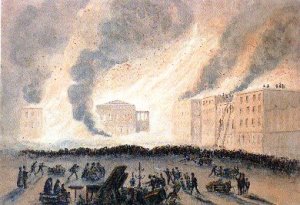 Included in the catalog is a reproduction of Marryat's watercolor "San Francisco Fire of 17 September 1850" and many Jewett portraits of famous people of the day including Gen. John A. Sutter.
Included in the catalog is a reproduction of Marryat's watercolor "San Francisco Fire of 17 September 1850" and many Jewett portraits of famous people of the day including Gen. John A. Sutter.
Come see rare pieces of Gold Rush history now on display in Sacramento and coming to you soon in Washington, D.C.
These pieces are currently found in the "Art of the Gold Rush" exhibit at the Crocker Art Museum in Sacramento where a collectors' item catalog of the same name accompanies the show.
This book, "Art of the Gold Rush" (University of California Press, $24.95), will be yours to thumb through long after the more than 75 pieces on display have been taken down and returned to the museums and collectors that lent them out. The exhibit, which opened at the Oakland Museum of California in January and moved to Sacramento in June, will end its stay at the Crocker on Sept. 13 when it moves to the National Museum of American Art in Washington, D.C., until March of 1999.
Three specialists contributed to this catalog: Jan Driesbach of the Crocker, Harvey L. Jones of the Oakland Museum, and Katherine Holland, an independent consultant.
It contains 75 color illustrations and 50 black and white illustrations, a critical element for a book on art.
"The book was printed in Italy," said Driesbach, "and the quality of the illustrations is wonderful."
Driesbach said her work on the manuscript that became "Art of the Gold Rush" was completed about a year ago, before she became consumed with additional responsibilities. Currently she is not only curator of art, but she is acting director of the museum until a replacement for Stephen McGough can be found.
Driesbach would have liked to have spent more time researching the lives of Gold Rush artists, but needed to meet deadlines.
"Research could go on ad infinitum," she said. "The Gold Rush not only left a visual legacy but many participants were people who had a high level of education. There's a lot of written documentation but only in a few cases did I have writing by artists, accounts of their time and work."
Two Gold Rush-era artists who did leave documentation are Frank Marryat of Britain and a portrait painter William Smith Jewett.
Jewett's original letters are held at the Bancroft Library ("He had terrible handwriting," said Driesbach) and Marryat published a book in 1855 about his experiences in California called "Mountains and Molehills or Recollections of a Burnt Journal."
 Included in the catalog is a reproduction of Marryat's watercolor "San Francisco Fire of 17 September 1850" and many Jewett portraits of famous people of the day including Gen. John A. Sutter.
Included in the catalog is a reproduction of Marryat's watercolor "San Francisco Fire of 17 September 1850" and many Jewett portraits of famous people of the day including Gen. John A. Sutter.
But not all of the Gold Rush-era artists who worked in the fields are remembered today.
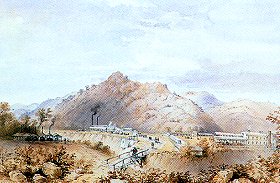 Driesbach said one of several works that make up her favorites in the exhibition is by an anonymous artist. This is the undated "Mining in California," on loan from a museum in Tulsa, Okla.
Driesbach said one of several works that make up her favorites in the exhibition is by an anonymous artist. This is the undated "Mining in California," on loan from a museum in Tulsa, Okla.
"It is a gorgeous little watercolor, absolutely beautiful," she said. It is reproduced on page 28, in the chapter written by Driesbach on "Scenes of Mining Life."
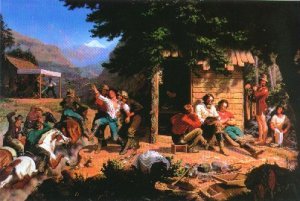 The most famous piece in the Crocker's permanent collection, a painting originally commissioned by Judge E.B. Crocker who built the museum, also graces the front and back cover of "Art of the Gold Rush." It is Charles Christian Nahl's "Sunday Morning in the Mines" (1872), and it is a key part of the traveling exhibition. This is a painting Driesbach knows well.
Therefore, you can understand her enthusiasm for another Nahl painting in the current exhibit, which is on loan from the Smithsonian Institution.
The most famous piece in the Crocker's permanent collection, a painting originally commissioned by Judge E.B. Crocker who built the museum, also graces the front and back cover of "Art of the Gold Rush." It is Charles Christian Nahl's "Sunday Morning in the Mines" (1872), and it is a key part of the traveling exhibition. This is a painting Driesbach knows well.
Therefore, you can understand her enthusiasm for another Nahl painting in the current exhibit, which is on loan from the Smithsonian Institution.
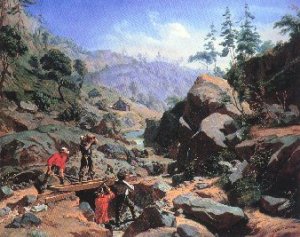 It is "Miners in the Sierra," an oil painting dated 1851, unusual in that Nahl and his brother-in-law Frederick Wenderoth, both German artists, share the credit. See this illustrated on page 50 of the catalog in the essay by Jones on "The Hessian Party."
It is "Miners in the Sierra," an oil painting dated 1851, unusual in that Nahl and his brother-in-law Frederick Wenderoth, both German artists, share the credit. See this illustrated on page 50 of the catalog in the essay by Jones on "The Hessian Party."
Driesbach said this is not the first time a collection like this has been gathered together but it is the first time since 1948, when the 100-year anniversary of the Gold Rush was celebrated with an exhibit in Los Angeles.
Work on the current exhibit began five years ago as Driesbach and Jones began working with art dealers, private collectors and museums to put the collection together.
"Both trained artists and amateurs recorded the unique landscapes and events they viewed in California in and immediately after 1848," said Driesbach, "but much of their production has been lost to various natural disasters including shipwrecks and fires that regularly consumed homes and possessions in the West."
But she says in many instances the artists and their heirs also failed to sufficiently appreciate the importance of first-person documentation of this extraordinary period in the state's history.
So come to the Crocker Art Museum before Sept. 13 for a close, personal look at the California Gold Rush. If you live on the East Coast, prepare to see the exhibit this fall. The book is available locally and at museum stores.
To inquire about ordering any of the above mentioned books from an independent bookstore,
The exhibit, "Art of the Gold Rush," was displayed at the Crocker Art Museum in Sacramento from June to September, 1998.
To view five samples from that exhibit go to Sherwin's "Crocker exhibition offers rare look at the Gold Rush," July 12, 1998 column.
.
Bogey's Books at discounted prices [ Click Here ]
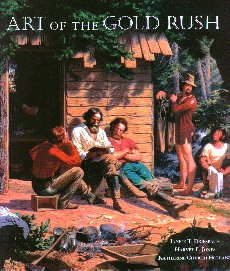 "Art of the Gold Rush" (University of California Press, $24.95)
"Art of the Gold Rush" (University of California Press, $24.95)
[Author Menu] [Date Menu] [Genre Menu] [Printed Matter Home]
The Davis Virtual Market ![]()